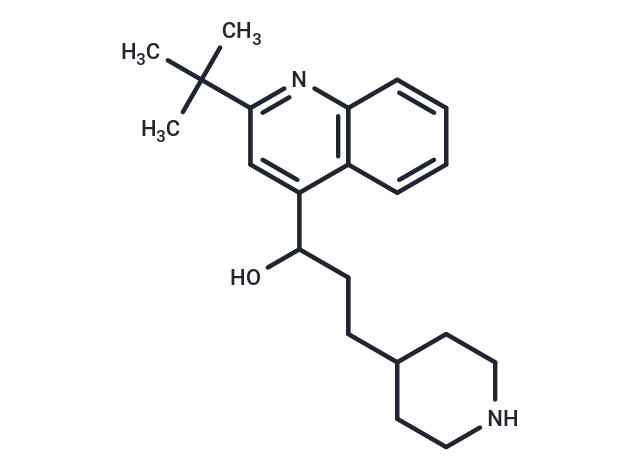Shopping Cart
- Remove All
 Your shopping cart is currently empty
Your shopping cart is currently empty

Quinacainol (RP 54272) is a new antiarrhythmic compound with class I antiarrhythmic effects in rats.

| Pack Size | Price | Availability | Quantity |
|---|---|---|---|
| 1 mg | $143 | In Stock | |
| 5 mg | $360 | In Stock | |
| 10 mg | $530 | In Stock | |
| 25 mg | $859 | In Stock | |
| 50 mg | $1,180 | In Stock | |
| 100 mg | $1,590 | In Stock |
| Description | Quinacainol (RP 54272) is a new antiarrhythmic compound with class I antiarrhythmic effects in rats. |
| In vitro | Quinacainol blocked sodium currents in a concentration-dependent manner and with a potency similar to that of quinidine (mean (+/-SEM) EC50 50+/-12 vs 95+/-25 micromol/L for quinidine and quinacainol, respectively). Quinacainol, a quinidine analog, blocks sodium currents in cardiac myocytes with little effect on I (to) or iKsus potassium currents, which suggests that quinacainol may be exerting class 1c anti-arrhythmic actions.[1] |
| In vivo | Evaluation of antiarrhythmic effects using Quinacainol in conscious rats with LAD coronary artery occlusion. Antiarrhythmic actions occurred with 2.0 and 4.0 mg/kg, whereas 8.0 mg/kg was pro-arrhythmic. At doses of 0.5 mg/kg and above, quinacainol increased threshold currents for capture and for ventricular fibrillation. Doses of 2.0 mg/kg and above increased ventricular refractoriness. From 1.0 to 8.0 mg/kg, quinacainol reduced dV/dtmax of phase 0 of epicardial action potentials but only 8.0 mg/kg increased action potential duration. The Q-T interval was also increased with the highest dose. Quinacainol dose-relatedly increased P-R interval whereas QRS did not change. Thus the Class I electrophysiological properties of quinacainol over the dose range tested did not fit accurately into a single subclass of the various subclasses of Class I. However, the Class Ic actions seen with 2.0 and 4.0 mg/kg were associated with antiarrhythmic actions.[2] |
| Alias | RP-54272, RP 54272, PK-10139, PK10139, PK 10139 |
| Molecular Weight | 326.48 |
| Formula | C21H30N2O |
| Cas No. | 86073-85-0 |
| Smiles | C(CCC1CCNCC1)(O)C=2C3=C(N=C(C(C)(C)C)C2)C=CC=C3 |
| Relative Density. | no data available |
| Storage | Powder: -20°C for 3 years | In solvent: -80°C for 1 year | Shipping with blue ice. | |||||||||||||||||||||||||||||||||||
| Solubility Information | DMSO: 50 mg/mL (153.15 mM) | |||||||||||||||||||||||||||||||||||
Solution Preparation Table | ||||||||||||||||||||||||||||||||||||
DMSO
| ||||||||||||||||||||||||||||||||||||

Copyright © 2015-2024 TargetMol Chemicals Inc. All Rights Reserved.